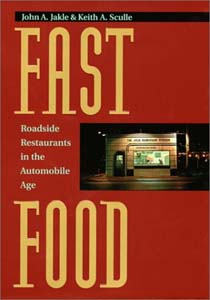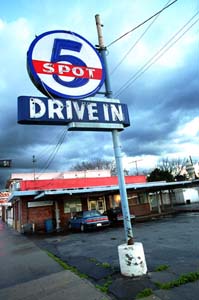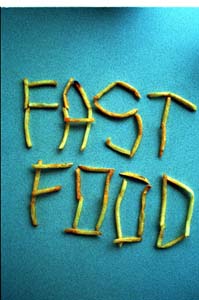![[Metroactive Books]](/books/gifs/books468.gif)
[ Books Index | San Jose | Metroactive Central | Archives ]
Burger Nation
How fast-food joints gave us a national cuisine and created a legion of grease-spattered service workers
By Richard von Busack
IN JULY 1954, a part-time big-band pianist and full-time milkshake-machine salesman named Ray Kroc called on a client in the California desert town of San Bernardino. As Kroc noted in his memoir, Grinding It Out, the restaurant was "a typical, ordinary drive-in" in the midst of a lunch-time rush. As the construction workers arrived looking for burgers, Kroc stopped to ask them what made this one stand special.
Kroc's attention was also struck by a girl in her car who had driven up for lunch. "In a bright yellow convertible sat a strawberry blonde who looked like she had lost her way to the Brown Derby or the Paramount cafeteria," Kroc recalled. "It was not her sex appeal but the obvious relish with which she devoured the hamburger that made my pulse hammer with excitement."
There in the parking lot of the McDonald brothers' hamburger stand, Kroc was clobbered by fate. You'd need to be an ancient Greek to come up with the right word to describe the immense destiny resting on the middle-aged salesman's shoulders. The lives of scores of millions of people--not to mention countless steers--flitted around him at that instant. (I was born in San Bernardino myself, four years later to the month, and I, too, was destined to serve my time as an insignificant speck in Kroc's cosmos.)
The fateful scene is summarized in John Jakle and Keith A. Sculle's Fast Food, the first comprehensive history of quick-service food in America. Fast Food completes "The Road and American Culture," a trilogy of works about our mobile society that includes Jakle's The Gas Station in America and The Motel in America.
Using the magic of franchising, Kroc transformed a San Berdoo burger shack into an instantly recognizable symbol of the U.S.A. Other businessmen before and after Kroc made millions from fast food, but when he created the most successful of all franchise restaurants, Kroc anchored a rootless culture by replicating the same dining experience from one end of the continent to the other.
The fast-food restaurant experience--whether it's hamburgers, hot dogs or pancakes--rarely varies from Maine to Monterey and has smoothed over the differences in our nation. McDonald's and its rivals have thus served the same purpose as the interstates and the railroads. Fast food has tied together a diverse nation through its commonness--it has given us a national cuisine.
Fast Food isn't just a chronicle of wildly successful businesses, though. The authors are in search of near-intangibles about exactly what it is that attracts customers to fast food--a question that obsesses them as much as how the franchises changed the nation.
The Clown, the King and the Little Red-Headed Girl
JAKLE AND SCULLE cook up several provocative conclusions about American fast food: "First, the quick-service restaurant served us in youthful years as 'alternative' places. Soda fountains, drive-in[s] and diners ... offered contrast to childhood home, although in introspection the restaurant and home seem closely linked."
Agreed. Most Americans have been eating fast food since they were old enough to gum it down. Most of us can recall trips to the local fast-food stand as a pleasant break from whatever emotions were floating around the family dinner table. And most readers, thinking back, will remember that they ate their first solitary meal--a stirring moment of independence--at a fast-food stand.
To be successful, fast-food places must to appeal to kids, which is why their advertising usually includes a logo character a child might like. Thus Howard Johnson's Simple Simon and the Pieman, and Ho-Jo the Clown. Later, out West, Ronald McDonald, Magic Burger King, the Jack in the Box and Wendy, David Thomas' cute li'l daughter.
All these comforting symbols tie into the second principle of fast food, according to Jakle and Sculle: "Restaurants attracted people not so much according to the food available as to the sense of place they offered."
Photograph by George Sakkestad
Rollergirls
BY THE TIME Kroc was transfixed by his blonde muse in her convertible--like the mysterious blonde in the T-Bird that glides through American Graffiti--the burger and the hot dog, the quintessential fast foods, had long been staples in the United States. But it's the vision of the carhop, that girl bearing an almost instant meal, that haunts nostalgics today.
"For the price of a hamburger, customers could enjoy a kind of beauty contest," Jakle and Sculle comment. Once there were thousands of drive-ins with carhops--a mostly extinct occupation today, like zeppelin mechanics--who brought a tray of food up to the car window. Who wants anyone knocking on their car window today?
Mostly, we remember carhops because of Mel's Drive-In, the San Joaquin Valley stand memorialized in American Graffiti. (Kroc prohibited that bevy of carhops at McDonald's. In fact, until the mid-'60s, McDonald's didn't hire teen-age girls at all. The problem? They attracted teen-age boys, and no businessman wanted idle teen-age boys hanging around his hamburger store.)
The drive-in with carhops lost its novelty, became expensive and mutated into the common drive-thru. By becoming part of the road instead of a part of the roadside, the fast-food restaurant changed its form and added an extra sense of speed by funneling traffic through, not past, the premises.
On a potentially hazardous road trip, the presence of fast-food restaurants was as much a comfort as the comfort food they served. "Anxiety from adventuring is contained by the familiar," Jakle and Sculle write. Further calming to anxiety was the layout of the first McDonald's outlets, which were glass-walled like aquariums, so that patrons could see the kitchen inside.
Kroc adapted this glass-walled shed from the parent McDonald's in San Bernardino. Being able to see inside a restaurant's kitchen calms fears about its cleanliness.
The glass-windowed model of the original McDonald's establishment changed when the chain started emphasizing indoor eating--when McDonald's became a destination and not just part of the road, in other words. Yet while fast-food architecture has changed, from novel and modern to commonplace and conservative, the work inside remains the same.
Which leads to another significant point raised by Jakle and Sculle: "[F]ast-food restaurants mean something very different to workers than to customers. The romance of the roadside, nostalgic or otherwise, pales for the average hourly employee. And the laborer's perspective is not that of management."
Photograph by George Sakkestad
Tartar Sauce
ALSO AGREED. Sculle writes a few paragraphs about the diner where he worked when he was a student decades ago. He says that the place had a 300-percent annual turnover, meaning that the staff changed completely three times a year. Where I worked, it was 200 percent.
I'd heard that the McDonald's in Westwood next to the UCLA campus was the second-busiest McDonald's in the world, after Tokyo. In ours, there were three parallel lines, like trenches in the Great War.
First came the counter space, packed with customers and a row of cashiers. Behind the cashiers sat the display counter, where the hamburgers waited to be bought and eaten. Behind the counter was the iron griddle, about as big as the roof of a minivan. At the backs of the fry cooks was the metal assembly table, where the burgers were put together. On the far side of the metal table, I stood for my six-hour shifts.
Usually, about seven bodies worked in this tight space, rushing around at full speed, adding to the discord of shouts and buzzers and the chiming of timers. I toasted the buns and spurted condiments on them with a metal ketchup and mustard spurter--and bagged fries in between. It was hot, and soon you sweated, and soon you stank. It was the first job I had, and also the first consciousness of having a stink.
In those days, the McDonald's uniform was nearly 100 percent polyester, and polyester doesn't breathe, it reeks. The uniform jacket boasted clown lapels, with a plastic zipper down the middle. It was sky-blue, an ecology color very popular in those days and considered suitable even for tuxedos.
Bagging fries was the best job, the cleanest one. It was fool-proof. You poured a 10-pound bag of pale, frozen raw fries into the greasy metal baskets and then lowered them into a vat for the right amount of time, which was measured by a shrieking alarm.
When done, the fries were dumped onto an aluminum tray under a heat lamp and frosted with salt. If ever a moment of peace presented itself in the midst of all this frantic activity, you were supposed to be swabbing the nearest surface. "If you have time to lean, you have time to clean," went the motto.
The grosser task was mopping up, whether floor or clogged toilet. Worse was operating the milkshake machine. The whizzing metal blades on the mixers tore the paper cups if you held them at the wrong angle. When that happened, the blender covered you from head to foot with a blow back of aerosolized Shamrock Shake droplets.
But the truly disgusting task--and it fell to people who tended the fry machine--was the filet of fish sandwich. Not the deep frying of the same, a relative cinch, but pouring the tartar sauce. The stuff came in a flimsy plastic jar that imploded as you poured out its contents. No mopping or washing could get the ooze off your skin, the floor or the stainless-steel surfaces.
If it didn't spill, the glop generally overfilled the top of the dispenser. The cursed thing choked with rapidly coagulating sauce and pickle bits, requiring cleaning even as the cook, the shift manager and the cashiers were bellowing for their fillets of fish. Never having time to lean or time to clean, I carried the mayonnaise-thick residue on my hands and arms and in my pores.*
Singing the Burger Electric
BECAUSE Fast Food is an academic study, Jakle and Sculle only touch upon the hard work that makes fast food possible. And sometimes, the authors look at their subject through a professorial pince-nez. Their toast-dry style ("Make no mistake about it--hamburgers are a business") detracts from this otherwise authoritative work.
But even at nearly 400 pages, they have left something out: the discontents of fast food. For example, consider the physical effects of overconsumption of fast food, the pace at which rain forest is turned to pasture land; the ethical problems of changing live animals to dead meat; the occasional risk of poisoning, as in the Jack in the Box E. coli outbreak in 1993 that killed four and sickened a thousand people (an incident that rates only one sentence in Fast Food), not to mention the terrific amount of waste in paper and containers that a fast-food restaurant produces.
As Midwestern writers, Jakle and Sculle don't seem to give California its due as a fast-food lab. Anaheim's Carl's Jr. recently bought the popular Midwestern chain Hardees. Burger King, though begun in Florida, was started by a man from Long Beach. Jack in the Box originated in San Diego. Baskin-Robbins and Big Boy both came out of Glendale. Irvine's In-N-Out Hamburgers--they're great!--is now making inroads in the Silicon Valley by recreating the model of McDonald's as it was four decades ago, complete with a narrow menu of just a few selections, paper hats and panopticon-style open kitchen. (In-N-Out also has a wage-and-benefits package unusual for the fast-food industry.)
Roy Allen and Frank Worth's first A&W root-beer stand was built in Lodi, and their A&W Sacramento location is a strong candidate for the title of first walk-up restaurant. Ray Kroc built his first McDonald's in Des Plaines, Ill., but he had his epiphany in Southern California.
Unfortunately, the way fast food and California go together leads to excess. To save money, many cash-strapped California high schools are allowing fast-food franchises space in their cafeterias, thus giving official approval of the habit of eating high-fat, empty-calory food. The American romance with fast food isn't universal, and there are fears that what homogenized the U.S.A. will homogenize the rest of the planet.
Jakle and Sculle are the most cautious of academics, but a note of wonder sounds in their writing when they consider the multiplicity of chains, franchises and forms. Vide Walt Whitman, they're singing the burger electric: "What an amazing, protean enterprise! ... like life in a vast sea." In this sea, the consumer is elusive, the fishermen wily and forced to change the bait often. Burger King once taunted their great rival with commercials ending "Watch out McDonald's!"
Jakle and Sculle point out that McDonald's always needs to watch out. The sea floor, to follow the author's metaphor, is littered with wrecks. Without constant evolution, any fast-food franchise is doomed. As permanent as McDonald's seems, it might be the stuff of nostalgia in a hundred years, as much a part of history as that girl Kroc ogled in that parking lot so many years ago.
A quick reading of the menu of Jack in the Box shows how the nation has changed since Kroc was dry-gulched by destiny in that near-mythical parking lot. Words like "jalapeño" and "teriyaki" are now on the menu, words easily understood by almost everyone who orders a Jumbo Jack. The history of fast food in America goes from drive-in to walk-up to drive-thru and now to "bundling"--as in the two-headed KFC/Taco Bell outlets that are sprouting up all over California.
Fast Food is, even with all of its research, a snapshot taken from a rapidly moving car. No wonder the authors end their labors with a call for more researchers to follow them, not just to see where we've been but where we're going.
[ San Jose | Metroactive Central | Archives ]
![]()

Fast Food: Roadside Restaurants in the Automobile Age
By John Jakle and Keith A. Sculle
Johns Hopkins University Press; 394 pages; $34 cloth
 Marked Menu: Once upon a time, America's roadside eateries and drive-ins, like the 5 Spot on Monterey Highway, beckoned to travelers with the promise of food on the run.
Marked Menu: Once upon a time, America's roadside eateries and drive-ins, like the 5 Spot on Monterey Highway, beckoned to travelers with the promise of food on the run.
 Eat and Run: What started as roadside fodder for travelers eventually became a franchised way of life.
Eat and Run: What started as roadside fodder for travelers eventually became a franchised way of life.
 Over-Arching Franchise: By providing the same dining experience from coast to coast, fast-food chains like McDonald's created a national cuisine.
Over-Arching Franchise: By providing the same dining experience from coast to coast, fast-food chains like McDonald's created a national cuisine.
* The money I made went to hippie accouterment, incense, overalls and records. In L.A., it cost a good deal of money to be a hippie. This was my foolish ambition, because the hippie girls at school that I liked seemed serene and lovable and sexy. They may have been less so because I was hanging with them vaguely smelling of tallow, or insincerity, or invisible but pungent karmic clouds of beef-death, which no incense would cover. (You've heard of sweets for the sweets--in my case, it was incense for the insensitive.) How many times in those days did someone ask me if I was a narc because of my "covertness" (to quote my first girlfriend). No paycheck, big or small, would have changed the nature of a suspicious, depressed, dodgy, forlorn burger jockey out of his 15-and-a-half-year-old depth in every aspect of life.
From the March 2-8, 2000 issue of Metro, Silicon Valley's Weekly Newspaper.